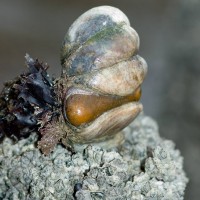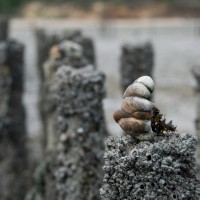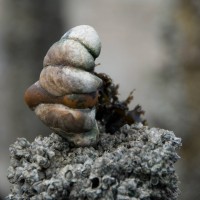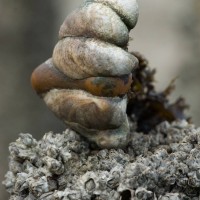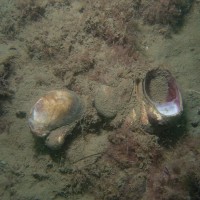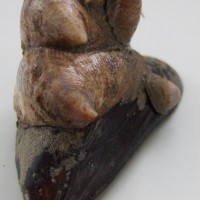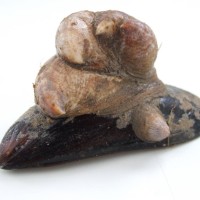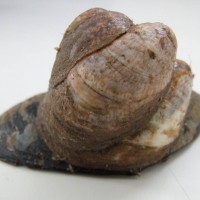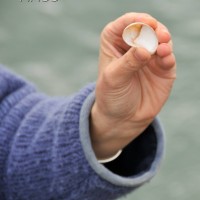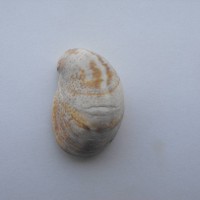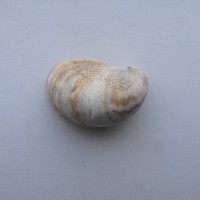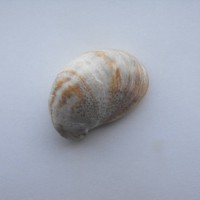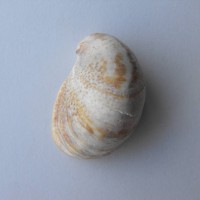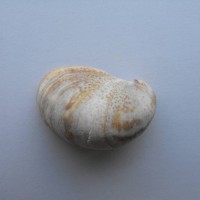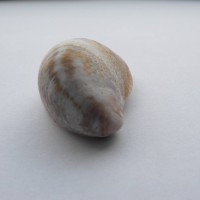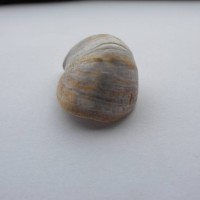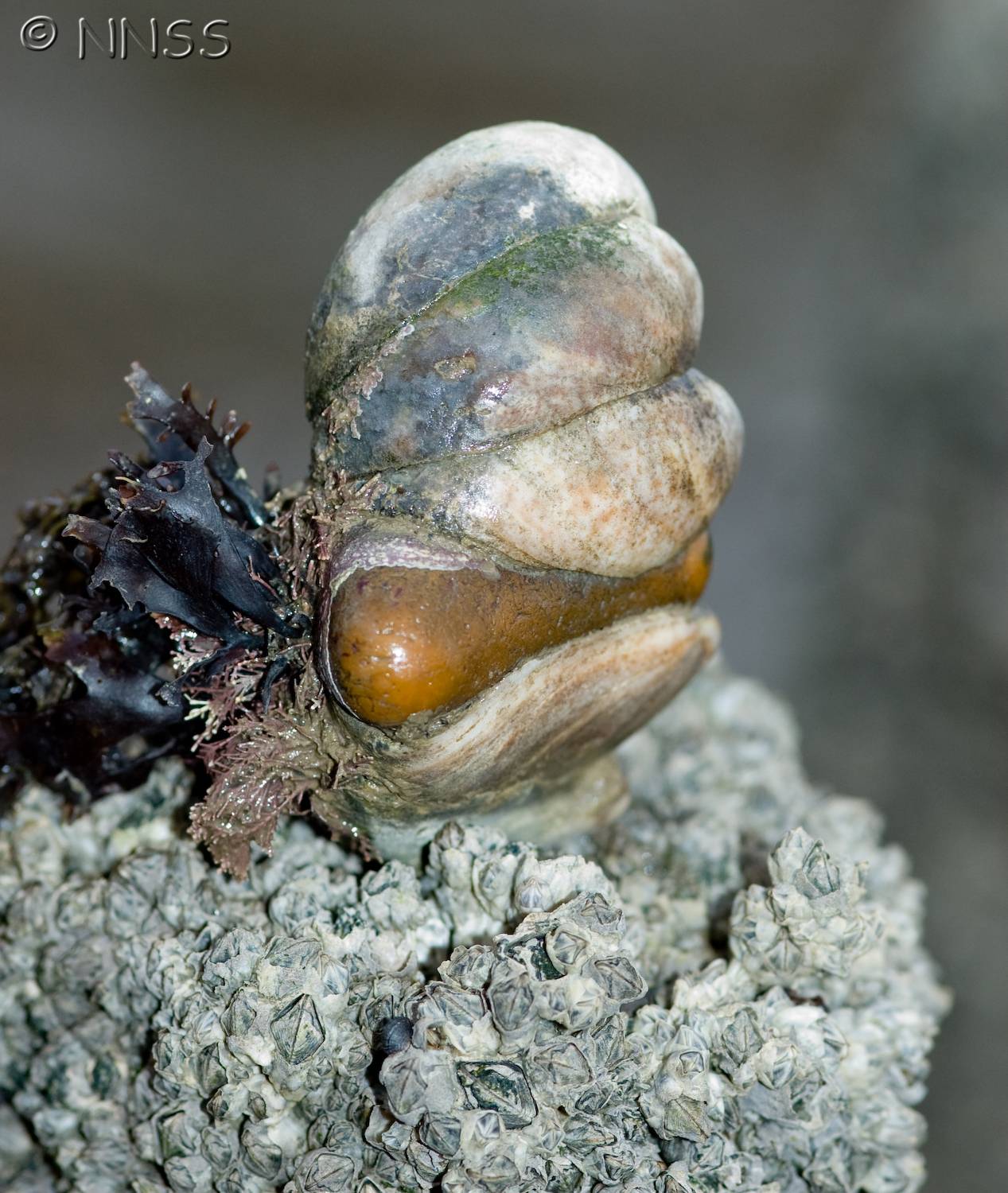
Slipper limpet - Crepidula fornicata
Expand and collapse the sections below by clicking on the title or + / - icons.
Short description of Crepidula fornicata, Slipper limpet
Shell is oval and up to 5 cm in length. The large shell opening has a shelf, extending half its length. Shell is smooth and white, cream, yellow or pinkish in colour with streaks or blotches of red or brown. Commonly found in curved chains or stacks made up of several individuals.
Impact summary: Crepidula fornicata, Slipper limpet
Can smother seabed species and alter seabed habitat structure dramatically. Competes for food and space with other filter-feeding species including mussels and oysters. Likely to consume the planktonic larvae of some species. Known to foul a variety of hard-shelled commercially important and farmed species and man-made structures and equipment.
Habitat summary: Crepidula fornicata, Slipper limpet
Adults live on the seabed on a variety of surfaces in a wide range of environmental conditions. Reaches its highest densities in wave protected muddy areas. Often attaches to the shells of dead and living hard-shelled invertebrates including scallops, crabs, whelks and mussels. Larvae are pelagic and are found in the water column.
Overview table
| Environment | Marine |
|---|---|
| Species status | Non-Native |
| Native range | Mexico, Alberta, British Columbia, Labrador, Manitoba, New Brunswick, Nova Scotia, Ontario, Saskatchewan, Yukon |
| Functional type | Filter-feeder |
| Status in England | Non-Native |
| Status in Scotland | Non-Native |
| Status in Wales | Non-Native |
| Location of first record | Liverpool Bay |
| Date of first record | 1872 |
Origin
The native range of the slipper limpet is from Point Escuminac, Canada along the eastern coast of America, down to the Caribbean.
First Record
Several successful GB introductions reported, the earliest was into Essex between 1887 and 1890. Populations found in Liverpool Bay in 1872 are thought to have since died out.
Pathway and Method
Most likely to have been imported with American oysters (Crassostrea virginica). May also be transported in ballast water, fouling on vessels and other man made objects, with fisheries and mariculture and naturally, attached to mobile "host" organisms.
Species Status
The slipper limpet has been introduced into numerous locations around Europe and on the western coast of America. It is thought to have been introduced into the Solent in the 1930s and by the 1970s, was thought to be the most dominant seabed creature in the area. By the 1960s, the population had spread to Start Point Devon and the species is currently common along the entire southern coast of England. This rapid domination and spread has been mirrored in suitable habitats elsewhere around Europe.
Dispersal Mechanisms
The larvae can move by themselves but are mostly carried by water movement, and can travel several kilometres a day. Direction of currents could be responsible for dispersal along northern European shores. Larvae can also be transported for several days in ballast water, being released into harbours or bays. Adults are able to attach to mobile species and ‘hitch’ a lift to new areas, such species include the common whelk (Buccinum undatum) the king scallop (Pecten maximus), turtles and crustaceans that scatter individuals when they moult.
Reproduction
The lower members of a slipper limpet chain are female, the upper, smaller members are male, and a central ‘zone’ is occupied by those changing sex. Breeding occurs between February and October, with peak activity in May and June. Most females spawn twice in a year, mainly after neap tides. Up to 11000 eggs in Stalked egg capsules are brooded under the foot of the female, attached to the inside of the shell or the foot. Young hatch as larvae after 3-4 weeks or less in warmer temperatures. The planktonic larval stage lasts 4-5 weeks and the larvae settle mainly in June-July in isolation or on top of an established chain. If an individual settles in isolation it will experience a brief male period, rapidly becoming a female, especially if another individual settles on it to initiate chain formation. If an individual settles on a chain it develops and remains as a male for up to 6 years, apparently stimulated to do so by pheromones released by females lower in the stack. Sex change takes approximately 60 days, during which the penis regresses and the pouches and glands of the female duct develop. This only occurs to the bottom-most male in a stack.
Known Predators/Herbivores
Likely to be preyed upon by certain species of crab, bird predatory starfish and predatory snails. Although experiments have shown the common shore crab (Carcinus maenus) and the starfish (Asterias rubens) prefer to feed on native mussels. Slipper limpets are also preyed on by the invasive American oyster drill (Urosalpinx cinerea).
Resistant Stages
The slipper limpet is tolerant of a wide range of temperature conditions through all life stages and can survive low water quality.
Habitat Occupied in GB
A range of seabed types, most abundant in areas of muddy seabed, with hard surfaces such as shells and cobbles. Also prefers areas sheltered from wave action suc as inlets, bays and estuaries. Will also occur on hard substrates and exposed areas in lower densities, both intertidally and below the low-water mark.
Native range from Point Escuminac (47oN) on the Canadian coastline down to the Caribbean Islands and Mexico. The slipper limpet is now distributed in Europe from Norway to the Mediterranean, with population explosions on the Atlantic coast of France, south and south-west England and the southern Netherlands. Also common along the Washington State coastline, USA, and the coasts of Honshu and Shikoku Islands, Japan. In GB, it is present on the east coast south of Spurn Head, the length of the south coast and northwards along the west coast to Cardigan Bay and has been recorded in Scotland and around the Hebridean Islands.
Environmental Impact
Spatial competition occurs when numerous stacks of slipper limpets prevent other seabed species from settling and through the deposition of faeces and sediments they reduce hard-surface habitat availability. Competition for food may occur with other filter feeding species, including certain bivalves. Attachment to species, including mussels and mobile species may lead to a reduction in survival, growth and reproduction of the host. On a large scale, slipper limpet stacks have been shown to disturb normal water flow, trapping fine suspended particles. Large numbers can also reduce drainage of oyster beds during ebb tides, disturbing oyster metabolism.
Health and Social Impact
A loss of amenity value caused by slipper limpet infestation may occur. In addition, traditional fishing practices may be affected and in areas heavily dependant on fishing, these social impacts may be serious.
Economic Impact
Bivalve fisheries and mariculture: Additional costs are likely to be associated with cleaning shells fouled with slipper limpets and sorting and gathering heavily infested catches. Loss of habitat for commercially important species may also occur The UK mussel and oyster fishery was worth £39.8 million in 2007. Oyster and mussel mariculture may also be affected by fouling, reducing the value of produce and increasing cleaning and handling time. Slipper limpet infestation may also lead to restrictions on movement of stock for growing and selling, leading to loss of revenue.
Identification
Rayment, W.J. (2007) Crepidula fornicata. Slipper limpet. Marine Life Information Network: Biology and Sensitivity Key Information Sub-programme [on-line]. Plymouth: Marine Biological Association of the United Kingdom. Available from <http:www.marlin.ac.ukspeciesCrepidulafornicata.htm>
Biology, ecology, spread, vectors
Blanchard, M. (1997) Spread of the slipper limpet Crepidula fornicata (L. 1758) in Europe. Current state and consequences. Scientia Marina, 61, 109-118.
de Montaudouin, X. & Sauriau, P.G. (1999) The proliferating Gastropoda Crepidula fornicata may stimulate macrozoobenthic diversity. Journal of the Marine Biological Association of the United Kingdom, 79, 1069-1077.
de Montaudouin, X., Audemard, C. & Labourg, P.J. (1999) Does the slipper limpet (Crepidula fornicata, L.) impair oyster growth and zoobenthos biodiversity? A revisited hypothesis. Journal of Experimental Marine Biology and Ecology, 235, 105-124.
Fretter, V. & Graham, A. (1981) The Prosobranch Molluscs of Britain and Denmark. Part 6. olluscs of Britain and Denmark. part 6. JournalHessland, I., 1951. Notes on Crepidula fornicata's further invasion of Europe. Arkiv för Zoologi, 2, 525-528.
Rayment, W.J. (2007) Crepidula fornicata. Slipper limpet. Marine Life Information Network: Biology and Sensitivity Key Information Sub-programme [on-line]. Plymouth: Marine Biological Association of the United Kingdom. Available from www.marlin.ac.ukspeciesCrepidulafornicata.htm
Management and impact
FitzGerald. A. (2007) Slipper Limpet Utilisation and Management. Report to Port of Truro Oyster Management Group.
General
Rayment, W.J. (2007) Crepidula fornicata. Slipper limpet. Marine Life Information Network: Biology and Sensitivity Key Information Sub-programme [on-line]. Plymouth: Marine Biological Association of the United Kingdom. Available from <http:www.marlin.ac.ukspeciesCrepidulafornicata.htm>
Global Invasive Species Database (2009) Fact sheet for Crepidula fornicata. Available from: www.issg.orgdatabasespeciesecology.asp?si=600&fr=1&sts
https://www.cabi.org/isc/datasheet/108234
https://secure.fera.defra.gov.uk/nonnativespecies/downloadDocument.cfm?id=754
Spotted this species?
Distribution map
View the Distribution map for Slipper limpet, Crepidula fornicata from NBN Atlas
ID Sheet
ID Sheet for Crepidula fornicata . See a full list of non-native species ID Sheets.
Risk assessment
Risk assessment for Crepidula fornicata. See a full list of non-native species Risk assessments.

